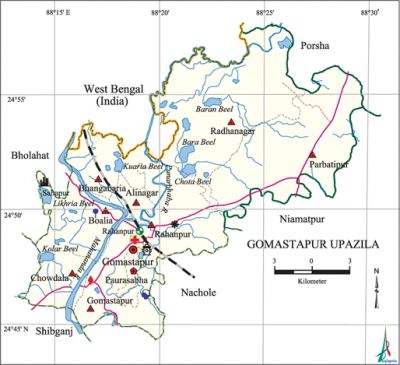Gomastapur Upazila
Gomastapur Upazila (nawabganj district) area 318.13 sq km, located in between 24°44' and 24°58' north latitudes and in between 88°13' and 88°58' east longitudes. It is bounded by west bengal of India and porsha upazila on the north, shibganj (Nawabganj) and nachole upazilas on the south, niamatpur and Nachole upazilas on the east, bholahat, Shibganj (Nawabganj) upazilas and West Bengal of India on the west.
Population Total 240123; male 122325, female 117798; Muslim 222568, Hindu 14420, Buddhist 1624, Christian 50 and others 1461. Indigenous communities such as santal, oraon, Munda, Mahali belong to this upazila.
Water bodies Main rivers: mahananda, punarbhaba; Kolar Beel, Kuaria Beel, Bara Beel, Baran Beel, Koral Beel, Damas Beel, Jhapai Beel and Likhria Beel are notable.
Administration Gomastapur Thana was formed in 1836 and it was turned into an upazila in 1983.
| Upazila | ||||||||
| Municipality | Union | Mouza | Village | Population | Density (per sq km) | Literacy rate (%) | ||
| Urban | Rural | Urban | Rural | |||||
|
1 |
8 |
166 |
227 |
50982 |
189141 |
755 |
44.7 |
32.8 |
| Municipality | ||||||||
|
Area (sq km) |
Ward |
Mahalla |
Population |
Density (per sq km) |
Literacy rate (%) | |||
|
14.38 |
09 |
33 |
30466 |
2119 |
49.5 | |||
| Upazila Town | ||||||||
|
Area (sq km) |
Mouza |
Population |
Density (per sq km) |
Literacy rate (%) | ||||
|
9.57 |
2 |
20516 |
2144 |
37.4 | ||||
| Union | ||||||||
| Name of union and GO code | Area (acre) | Population | Literacy rate (%) | |||||
| Male | Female | |||||||
|
Alinagar 10 |
1971 |
7263 |
7172 |
31.18 | ||||
|
Gomastapur 52 |
8531 |
18393 |
18028 |
36.45 | ||||
|
Chowdala 42 |
4596 |
15582 |
14936 |
27.71 | ||||
|
Parbatipur 63 |
18747 |
15974 |
15446 |
36.94 | ||||
|
Bhangabaria 21 |
5800 |
11410 |
11169 |
28.06 | ||||
|
Boalia 31 |
7444 |
11995 |
11949 |
31.81 | ||||
|
Radhanagar 73 |
20055 |
17671 |
17153 |
36.87 | ||||
|
Rohanpur 84 |
11467 |
8192 |
7324 |
33.06 | ||||
Source Bangladesh Population Census 2001, Bangladesh Bureau of Statistics.

Archaeological heritage and relics Stupa at village Naoda, single domed look-out tower (Rohanpur), Shahapur Garh.
Marks of the War of Liberation Mass grave 1.
Literacy rate and educational institutions Average literacy 35.4%; male 37.4%, female 33.2%. Noted educational institutions: Rohanpur Yusuf Ali College (1967), Gomastapur Soleman Mia College (1984), Rohanpur AB Government High School (1942),' Gomastapur Pilot High School (1949).
Newspapers and periodicals Protiva Bikash, Rohanpur Barta.
Cultural organisations Library 3, club 10, health club 1, cinema hall 3, women's organisation 20.
Main sources of income Agriculture 62.45%, non-agricultural labourer 4.75%, industry 1.61%, commerce 16.87%, transport and communication 1.33%, service 3.45%, construction 1.16%, religious service 0.17%, rent and remittance 0.11% and others 8.10%.
Ownership of agricultural land Landowner 38.30%, landless 61.70%; agricultural landowner: urban 36.31% and rural 38.81%.
Main crops Paddy, potato, wheat, corn, tomato vegetables.
Extinct or nearly extinct crops Mustard, linseed, kaun, arhar.
Main fruits Jackfruit, mango, banana, water-melon.
Fisheries, dairies and poultries This upazila has a number of dairies and poultries.
Communication facilities Pucca road 90 km, semi-pucca road 05' km, mud road 385 km; railway 11 km.
Extinct or nearly extinct traditional transport Palanquin, horse carriage.
Noted manufactories Ice factory, biscuit factory, welding factory.
Cottage industries Goldsmith, blacksmith, potteries, weaving, bamboo and wood work.
Hats, bazars and fairs Hats and bazars are 17, fairs 2, most noted of which are Rohanpur Hat, Santoshpur Hat, Gomastapur Hat, Chowdala Bazar, Parbatipur Bazar; Kalupur Mela and Parbatipur Adda Mela.
Main exports Mango, tomato, paddy, rice.
Access to electricity All the wards and unions of the upazila are under rural electrification net-work. However 16.18% of the dwelling households have access to electricity.
Sources of drinking water Tube-well 96.30%, tap 0.56%, pond 0.25% and others 2.89%. The presence of arsenic in an intolerable level has been detected in 861 out of 5724 shallow tube-wells of the upazila.
Sanitation 10.41% (rural 6.30% and urban 26.44%) of dwelling households of the upazila use sanitary latrines and 36.85% (rural 36.28% and urban 39.05%) of dwelling households use non-sanitary latrines; 52.74% of households do not have latrine facilities.
Health centres Upazila health centre, family planning centre, satellite health centre, eye hospital and Christian mission.
NGO activities Operationally important NGOs are caritas, proshika, brac, asa, BAIS, Prayas. [ Mahbubur Rahman Rana]
References Bangladesh Population Census 2001, Bangladesh Bureau of Statistics; Cultural survey report of Gomastapur Upazila 2007.
